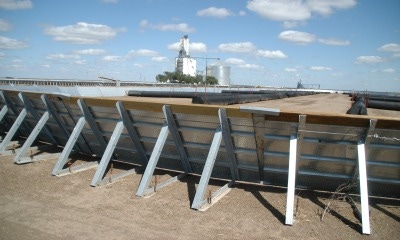
The good news is this is shaping up to be one of those rare years when Kansas see an excellent winter wheat harvest followed by an excellent fall harvest.
That prospect gives rise to a big question: Where can it be stored?
"It's certainly going to be difficult," says Tom Tunnell, president and CEO of the Kansas Feed and Grain Association. "On the bright side, we have added a lot of storage in the past several years. And even though we have a tremendous wheat harvest -- we're probably going to see up to 430 million bushels -- we have seen wheat harvests as big as 500 million bushels in the past so storage for wheat should be there."

NOT YESTERDAY'S GROUND: Kansas grain handlers have added millions of bushes of bunker storage in recent years. Modern bunkers minimize losses with solid outside walls, tarp covers and aeration systems. But moving grain in and out of bunkers is still far more time and labor intensive that lhandling grain in bins.
As the combines roll for corn, milo and soybean harvest, however; it could get dicey, especially if wheat sales continue to be stagnant.
"We are still trying to figure things out," said Charlie Swayze, manager of SCE at Isabel. "We have people who carried over winter wheat from last year. If they decide to sit on this harvest, we're going to still be full of wheat when fall harvest starts coming in."
Swayze said dryland corn in his area of southwest Kansas looks almost as good as irrigated corn. Soybeans also are in good shape.
With wheat markets stagnant, it's going to be difficult to find a place to put that fall crop, he said.
One option for elevators may be the additional of bunker storage, which has been growing rapidly, especially in western Kansas, where corn and milo tend to move steadily to feedlots and ethanol plants and both crops tend to store better in bunkers than either winter wheat or soyhbeans.
"You don't want to put up a bunch of new bins and then not need them a few years from now," he said.
Putting in bunkers is less expensive and you can stack them up and store them if you don't need to use them in the future."
Putting grain into bunkers has come a long way from the old days of "going on the ground" Tunnell said.
"Bunkers have solid sidewalls, tarp covers and aeration," he said, "It helps preserve grain quality and avoid temperature and moisture problems. Bunkers are not that expensive to build, but handling grain in and out of them is very labor intensive."
Tunnell said the transportation resources to move grain out are in good shape this year.
"We haven't seen problems with being able to get rail cars to move it," he said. "The problem is a market to move it to. Wheat just isn't selling."
An added problem for moving the winter wheat crop this year is that overall protein levels have been lower than domestic millers like to see and they are not buying, Swayze said.
"That leaves it sitting here waiting to go to the Gulf and overseas," he said.
About the Author(s)
You May Also Like






